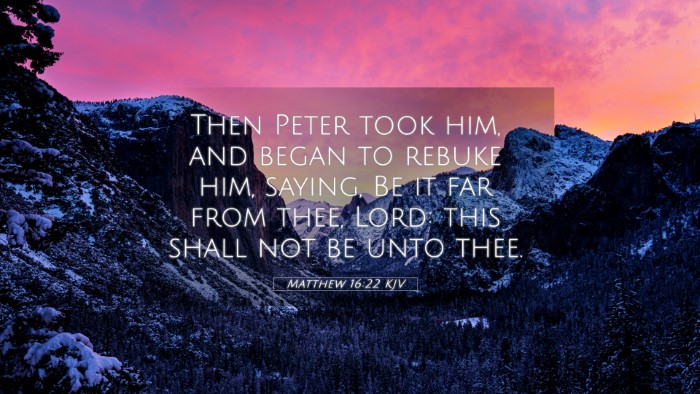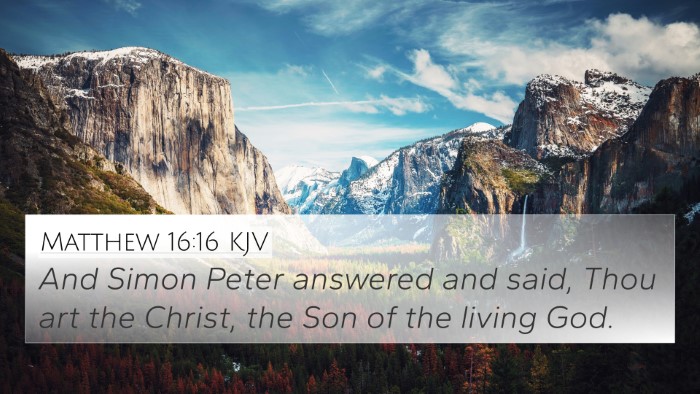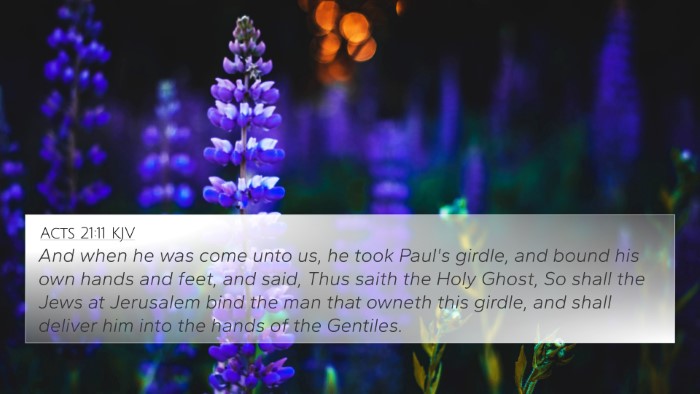Understanding Matthew 16:22
Matthew 16:22 presents a significant moment in the Gospels. In this verse, Peter confronts Jesus after He predicts His suffering and death. The profound implications of this interaction warrant a deeper exploration.
Verse Context and Analysis
In Matthew 16:21, Jesus reveals to His disciples the necessity of His impending suffering, death, and resurrection. This revelation stuns the disciples, particularly Peter, who responds with vigorous opposition.
Verse Breakdown
Here is the verse in context:
"And Peter took Him aside and began to rebuke Him, saying, 'Far be it from You, Lord; this shall not happen to You!'" (Matthew 16:22)
Commentary Insights
Various commentators provide insight into the meaning and implications of this verse:
- Matthew Henry:
Henry emphasizes Peter's genuine intentions in rebuking Jesus, highlighting the natural human instinct to avoid suffering. He illustrates this moment as a clash between divine purpose and human understanding.
- Albert Barnes:
Barnes notes that Peter's reaction demonstrates a misunderstanding of Jesus’ mission. Instead of embracing the necessity of the cross, Peter's response shows the challenge of comprehending divine plans which may not align with human desires.
- Adam Clarke:
Clarke points out Peter’s ignorance of the prophetic necessity of Christ’s suffering, relating this to broader themes of human resistance to God’s will. He emphasizes the importance of accepting God’s path even when it leads through hardship.
Key Themes in Matthew 16:22
Several themes emerge from Matthew 16:22 that contribute to our understanding of this interaction:
- Human Rejection of Suffering: Peter's rebuke resonates with the universal human aversion to pain and suffering.
- Divine Purpose vs. Human Understanding: The clash between what humanity desires and what God has ordained is a central theme in this passage.
- Discipleship and Sacrifice: This verse highlights the challenges of discipleship, particularly how following Christ requires embracing the cross.
- Faith and Obedience: The necessity of faith in God's plan, even when it contradicts personal desires, is paramount in interpreting this passage.
- Messianic Expectations: This moment illustrates the unexpected nature of Jesus as the Messiah and our preconceived notions of what such a role entails.
Bible Verse Cross-References
To deepen your understanding, here are several Bible verses that relate to Matthew 16:22:
- Isaiah 53:3: This verse speaks to the suffering servant, prefiguring Christ’s suffering and rejection.
- Luke 9:22: In this parallel account, Jesus reiterates the necessity of His suffering.
- John 12:27: Here, Jesus reflects on His own troubled spirit as He faces the purpose of His coming.
- Romans 8:28: This verse reminds us that God can work through suffering for a greater good.
- Philippians 1:29: It emphasizes that believers are called not only to believe in Jesus but also to suffer for His sake.
- 2 Timothy 3:12: This verse clarifies that all who live godly lives will face persecution, aligning with the theme of suffering for Christ.
- 1 Peter 2:21: Peter himself later writes about following Christ's example in suffering, emphasizing the believer's call to endure trials.
- Matthew 26:39: In Gethsemane, Jesus expresses the overwhelming burden of what He is to face, reinforcing the theme of divine purpose in suffering.
- Matthew 10:38: Jesus speaks about the necessity of taking up one’s cross, an invitation to participate in His suffering.
- Hebrews 12:2-3: The verses encourage believers to look to Jesus, the author and finisher of our faith, who endured the cross for the joy set before Him.
Conclusion
Matthew 16:22 vividly portrays the struggle between human emotion and the divine plan. Through Peter's rebuke, we are reminded that understanding God's will often challenges our preconceived notions of faith, suffering, and discipleship. The cross-references provided serve as a rich resource for deeper exploration and understanding of these crucial themes in both the Old and New Testaments.
Further Study on Cross-Referencing
Utilizing cross-references in the Bible can enrich your study. Here are some tools and tips:
- Bible Concordance: A useful tool for finding related verses and deeper thematic connections.
- Cross-Reference Bible Study: Engaging in cross-referencing can unveil broad themes and narratives across the scripture.
- Identifying Connections: Explore connections between Old and New Testament verses to gain a fuller understanding of Biblical themes.
- Scriptural Cross-Referencing: This method enhances comprehension of how various Biblical texts converse with each other contextually and thematically.
- Bible Reference Resources: Use various study aids to trace thematic developments throughout the Bible.
This comprehensive approach to Matthew 16:22, enriched with insights from prominent commentaries and relevant cross-references, provides a profound understanding of this pivotal moment in Jesus' ministry.








